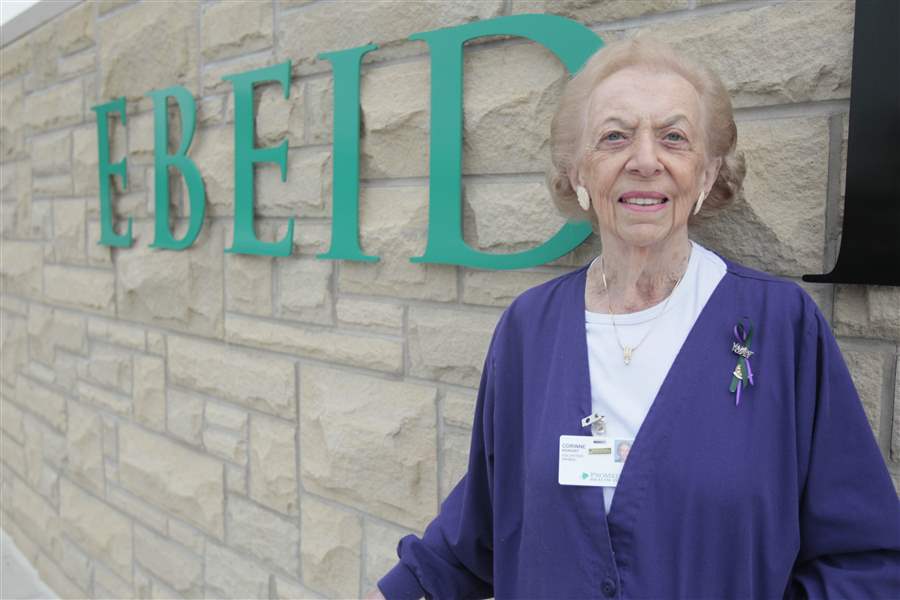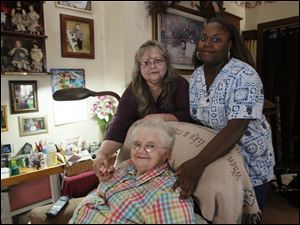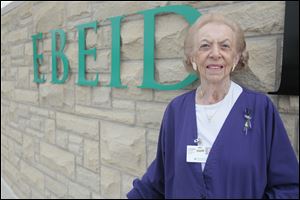
More ailing, aging loved ones are being cared for by relatives
8/7/2011
Corinne Krakoff, a volunteer at Ebeid Hospital in Sylvania, was instrumental in starting hospice at Lake Park and in starting the Swan Creek Retirement Village.
The Blade/Lisa Bernheim
Buy This Image

Mary Jackson, 80, seated with her daughter Pam Feichter, standing at left, and caretaker Shantoya Lyons, has lived with her adult daughter and son-in-law Bob since Ms. Jackson's heart attack several years ago. Ms. Lyons, an STNA with Comfort Keepers, works at the family home 25 hours a week through the PASSPORT program.
More than 43 million Americans each year provide care for their elderly parents, doing everything from making sure they have groceries to providing intensive in-home health services. On Sunday The Blade looks at the overall issue and how state programs such as PASSPORT help. Caregivers and their concerns are explored Monday on the Science and Health page.
The We Generation
For centuries, it was not unusual for multiple generations to live under one roof, with a grandparent among the oldest and toddlers the youngest.
But several decades ago, that cultural norm gave way to an expanding and increasingly mobile society. When teenagers went away to college, some got jobs, married, and raised families in cities far from their parents and hometowns. Wives and mothers joined the workforce in large numbers, and workers gave in to job demands and spent more time at work.
MONDAY
A look at the issues adult children face taking care of their aging parents.
READ MORE: Medicaid stigma keeps some from seeking aid
Family dynamics changed and adult children became sandwiched between the young children they were trying to raise and their aging parents who demanded more care. In many cases, adult children didn’t have the luxury of time, so frail parents went to nursing homes.
Now, as baby boomers age, they are the movers and shakers of a graying brigade. AgingStats.gov notes that baby boomers are among the 37 million Americans who are 65 and older, representing 12 percent of the population. It also shows that 5.3 million Americans are 85 and older; many of them are being cared for by their aging children.
One study says that some 10 million adult children age 50 and up care for their parents. The MetLife Study of Caregiving Costs to Working Caregivers: Double Jeopardy for Baby Boomers Caring for Their Parents, reported in Elder Law Answers that caregivers forfeit a collective $3 trillion in wages, pension, and Social Security benefits, as a result of caring for their parents. The report states that the caregivers are more likely to be in poorer health than relatives who don’t provide care for the aged.
The trend to keep ailing and aging loved ones at home and out of nursing homes is going in that direction for several reasons:
● Many elderly people are in better health, do well on their own as they age, and prefer to remain in their own homes.
● The elderly have more care options, including assisted living and home care.
● States are allocating fewer dollars to nursing homes. It costs $62,000 a year to care for a senior citizen in an Ohio nursing home, said Justin Moor, vice president of communications and operations at the Area Office on Aging. In Ohio, Medicaid pays 70 percent of the nursing home costs.Meanwhile, a state program called PASSPORT — which stands for Pre-Admission Screening System Providing Options and Resources Today — provides the elderly Medicaid recipient at-home care for about a third of what it costs to care for someone in a nursing home, Mr. Moor said.
Wealth of services
Though the trend for the elderly to remain at home or with relatives is more desirable to them and their families, caregiving is no small feat.
"I cannot do this by myself," said Pam Feichter of Toledo. Ever since her 80-year-old mother, Mary Jackson, had open-heart surgery several years ago, she has lived with her and her husband, Bob.

Corinne Krakoff, a volunteer at Ebeid Hospital in Sylvania, was instrumental in starting hospice at Lake Park and in starting the Swan Creek Retirement Village.
"I’m really lucky to have her," Ms. Jackson said of her daughter.
Fortunately for Mrs. Feichter and Ms. Jackson, both members of a growing demographic, there is a wealth of services available to the elderly and their caregivers. For Ms. Jackson, that means getting 25 hours a week — paid for by PASSPORT — from Shantoya Lyons, who works for Comfort Keepers, a private agency that gives in-home elder care. The annual cost to care for someone at home is about a third of what it costs in a nursing home.
"She makes me feel safe," Ms. Jackson said about Ms. Lyons. "I don’t want to go to a nursing home."
Other senior citizens don’t either, and they are pleased that the PASSPORT program makes it possible for them to live independently or in the home of a relative.
"They cannot take this program away," Ms. Jackson said.
Increased state support
Ohio legislators did not slash PASSPORT, the Medicaid waiver program, by a total of 23 percent as had been threatened. The final budget increased PASSPORT spending by $55.6 million through 2013, which means that 4,800 more Ohioans will be allowed to get home and community-based services through PASSPORT.
Additionally, the state budget allows for $166 million more over the next two years in total Medicaid spending for long-term care services, the umbrella that covers PASSPORT. This means the Northwest Ohio Area Office on Aging will keep servicing the elderly in its 10-county area. In 2010, that agency provided services to 4,400 seniors in its 10-county area; 2,754 of them received PASSPORT aid.
Among the services that PASSPORT provides are housecleaning, repair of broken locks and windows, home-delivered meals, occupational therapy, personal care, transportation, medical supplies, and durable medical equipment.
Those services are provided through agencies such as Visiting Angels, of which there are about 400 franchises in this country, Canada, and the United Kingdom. Tamera Riggs, owner and director of a local Visiting Angels, said the services her agency provides are paid for by PASSPORT for those recipients and, for those who have it, with private funds and long-term care insurance.
While some agencies like hers require a client to sign up to receive a minimum of four hours of service at a time, Visiting Angels gives a client service for a minimum of two hours up to 24 hours. Mrs. Riggs said most of her clients want a couple of hours each in the mornings and evenings.
The graying population is behind groups springing up to meet their needs and it is forcing existing organizations to meet elderly demands. For example, there are moving companies whose Web sites explain that they are sensitive to the fact that elderly people have difficulty making the transition from the home where they lived for decades to a relative’s home or facility for mature citizens.
Although seniors needing hands-on care who move into retirement communities probably don’t need PASSPORT, the emotional strain on them is undoubtedly as intense as it is for those moving into an adult child’s home. A local volunteer, advocate, and consultant on elder-care issues has a perspective that mature persons who are apprehensive about moving into a retirement facility might want to ponder.
"I have found that people who were living at home alone begin to thrive in a retirement community, where they are eating with friends," said Corrine Krakoff, 85, of Ottawa Hills. She added, laughing, "And they don’t have to do the dishes."
Moving to a relative’s house into just a single bedroom with or without an attached bathroom, or moving into a retirement apartment with less square footage than what they are used to is tough. But Mrs. Krakoff points out that these changes help force seniors to socialize.
"The apartments are small by design," said Mrs. Krakoff, who said it was her idea to establish the first hospice beds at Lake Park on ProMedica’s Flower Hospital grounds in Sylvania, and that she was instrumental in starting the Swan Creek Retirement Village.
"You are supposed to spend your time in the big community rooms," said Mrs. Krakoff, who also volunteers at the Ebeid Hospice near Flower. "That’s the idea: socialization."
And residents who are still ambulatory can take advantage of planned activities. Whenever their health begins to decline, help is readily available.
Whether it’s to a retirement community or the home of a resident, the goal is obvious.
"Basically, we work to keep people out of nursing homes," Mrs. Riggs said.
And that most often is the goal not just of aging parents, but their adult children as well.
Contact Rose Russell at: rrussell@theblade.com or 419-724-6178.